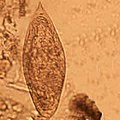Schistosoma intercalatum
Schistosoma intercalatum is a species of trematode, or fluke, belonging to the genus Schistosoma. It is one of the parasites responsible for schistosomiasis, a disease that is endemic in certain parts of Africa. Schistosomiasis, also known as bilharzia or snail fever, is a significant public health concern in affected regions, with Schistosoma intercalatum primarily affecting the intestinal system of its human hosts.
Life Cycle[edit]
The life cycle of Schistosoma intercalatum is complex, involving two hosts: a definitive human host and an intermediate snail host. The cycle begins when eggs are excreted in the feces of an infected person. If these eggs reach freshwater, they hatch into free-swimming larvae called miracidia. These miracidia infect a specific freshwater snail species, where they develop into another larval form, cercariae. The cercariae are released back into the water and can penetrate the skin of humans who come into contact with contaminated water. Once inside the human body, the cercariae develop into adult worms, which reside in the blood vessels of the intestines. The adult worms then produce eggs, some of which are passed out of the body in feces, continuing the cycle.
Symptoms and Treatment[edit]
Infection with Schistosoma intercalatum can lead to a range of symptoms, from mild or asymptomatic cases to severe intestinal damage. Early infection may cause dermatitis or a rash, known as "swimmer's itch," due to the cercarial penetration. Chronic infection primarily affects the intestines, leading to symptoms such as abdominal pain, diarrhea, and blood in the stool. In severe cases, liver and spleen enlargement may occur.
Treatment for schistosomiasis caused by Schistosoma intercalatum typically involves the use of antiparasitic medications, with praziquantel being the most effective and commonly used drug. Preventive measures focus on reducing exposure to contaminated water and include improving sanitation, snail control, and health education.
Epidemiology[edit]
Schistosoma intercalatum is endemic to certain parts of Central and West Africa, with the highest prevalence in rural areas where access to clean water and sanitation is limited. The distribution of Schistosoma intercalatum is closely related to the distribution of its snail hosts, which thrive in specific freshwater environments.
Prevention[edit]
Prevention strategies for schistosomiasis caused by Schistosoma intercalatum include improving access to clean water, promoting good hygiene practices, snail control programs to reduce the population of the intermediate host, and health education campaigns to raise awareness about the risks of exposure to contaminated water.
Research and Control Programs[edit]
Ongoing research into schistosomiasis includes the development of vaccines, improved diagnostic tests, and new drug treatments. Control programs often involve mass drug administration in endemic areas, aiming to reduce the prevalence of the disease and interrupt its transmission cycle.
-
Schistosoma intercalatum egg
Ad. Transform your life with W8MD's Budget GLP-1 injections from $75


W8MD offers a medical weight loss program to lose weight in Philadelphia. Our physician-supervised medical weight loss provides:
- Weight loss injections in NYC (generic and brand names):
- Zepbound / Mounjaro, Wegovy / Ozempic, Saxenda
- Most insurances accepted or discounted self-pay rates. We will obtain insurance prior authorizations if needed.
- Generic GLP1 weight loss injections from $75 for the starting dose.
- Also offer prescription weight loss medications including Phentermine, Qsymia, Diethylpropion, Contrave etc.
NYC weight loss doctor appointmentsNYC weight loss doctor appointments
Start your NYC weight loss journey today at our NYC medical weight loss and Philadelphia medical weight loss clinics.
- Call 718-946-5500 to lose weight in NYC or for medical weight loss in Philadelphia 215-676-2334.
- Tags:NYC medical weight loss, Philadelphia lose weight Zepbound NYC, Budget GLP1 weight loss injections, Wegovy Philadelphia, Wegovy NYC, Philadelphia medical weight loss, Brookly weight loss and Wegovy NYC
|
WikiMD's Wellness Encyclopedia |
| Let Food Be Thy Medicine Medicine Thy Food - Hippocrates |
Medical Disclaimer: WikiMD is not a substitute for professional medical advice. The information on WikiMD is provided as an information resource only, may be incorrect, outdated or misleading, and is not to be used or relied on for any diagnostic or treatment purposes. Please consult your health care provider before making any healthcare decisions or for guidance about a specific medical condition. WikiMD expressly disclaims responsibility, and shall have no liability, for any damages, loss, injury, or liability whatsoever suffered as a result of your reliance on the information contained in this site. By visiting this site you agree to the foregoing terms and conditions, which may from time to time be changed or supplemented by WikiMD. If you do not agree to the foregoing terms and conditions, you should not enter or use this site. See full disclaimer.
Credits:Most images are courtesy of Wikimedia commons, and templates, categories Wikipedia, licensed under CC BY SA or similar.
Translate this page: - East Asian
中文,
日本,
한국어,
South Asian
हिन्दी,
தமிழ்,
తెలుగు,
Urdu,
ಕನ್ನಡ,
Southeast Asian
Indonesian,
Vietnamese,
Thai,
မြန်မာဘာသာ,
বাংলা
European
español,
Deutsch,
français,
Greek,
português do Brasil,
polski,
română,
русский,
Nederlands,
norsk,
svenska,
suomi,
Italian
Middle Eastern & African
عربى,
Turkish,
Persian,
Hebrew,
Afrikaans,
isiZulu,
Kiswahili,
Other
Bulgarian,
Hungarian,
Czech,
Swedish,
മലയാളം,
मराठी,
ਪੰਜਾਬੀ,
ગુજરાતી,
Portuguese,
Ukrainian

